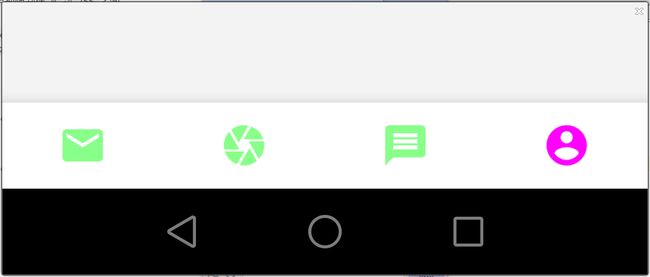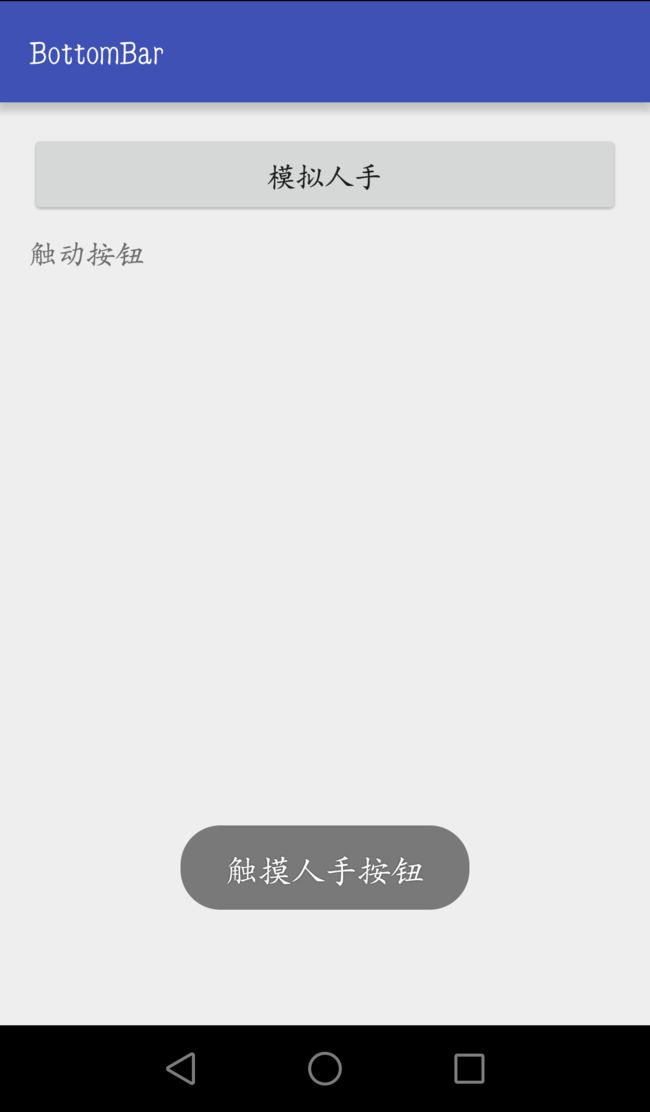Android Material Design (底部导航栏)
我们活着不能与草木同腐,不能醉生梦死,枉度人生,要有所作为。——方志敏
概述
我们挑战自我,为用户创造了崭新的视觉设计语言。与此同时,新的设计语言除了遵循经典设计定则,还汲取了最新的科技,秉承了创新的设计理念。这就是原质化设计(Material Design)。同时具有界面更干净、更简约,支持各种新动画效果,具有内置的实时UI阴影,以及可在不同屏幕之间切换的hero元素等特点。
我们先来看看底部导航栏最终效果,有图才有真相嘛:
下面我们一起来看看它的具体实现。
相关方法
setColorFilter
setColorFilter可以实现滤镜效果。我们可以使用setColorFilter实现仿微信底部导航栏效果。
方法预览:
public final void setColorFilter(int color)
public final void setColorFilter(int color, Mode mode)
public void setColorFilter(ColorFilter cf)参数 :
color 滤镜颜色
mode 混合模式(枚举型)
cf 每一个RGB通道应用转换
mode的枚举值:
PorterDuff.Mode.CLEAR绘制不会提交到画布上PorterDuff.Mode.SRC显示上层绘制图片PorterDuff.Mode.DST显示下层绘制图片PorterDuff.Mode.SRC_OVER正常绘制显示,上下层绘制叠盖。PorterDuff.Mode.DST_OVER上下层都显示。下层居上显示。PorterDuff.Mode.SRC_IN取两层绘制交集。显示上层。PorterDuff.Mode.DST_IN取两层绘制交集。显示下层。PorterDuff.Mode.SRC_OUT取上层绘制非交集部分。PorterDuff.Mode.DST_OUT取下层绘制非交集部分。PorterDuff.Mode.SRC_ATOP取下层非交集部分与上层交集部分PorterDuff.Mode.DST_ATOP取上层非交集部分与下层交集部分PorterDuff.Mode.XOR变暗PorterDuff.Mode.DARKEN调亮PorterDuff.Mode.LIGHTEN用于颜色滤镜PorterDuff.Mode.MULTIPLYPorterDuff.Mode.SCREEN
CLEAR模式:
你对其他模式感兴趣的话,可以写个例子测试下。
ColorFilter 参数是对每一个RGB通道应用转换 ,Android包含三个ColorFilter:
ColorMatrixColorFilter可以指定一个4×5的ColorMatrix并将其应用到一个Paint中。ColorMatrixes通常在程序中用于对图像进行处理 ,而且由于它们支持使用矩阵相乘的方法来执行链接转换,所以它们很有用。LightingColorFilter乘以第一个颜色的RGB通道,然后加上第二个颜色。每一次转换的结果都限制在0到255之间。PorterDuffColorFilter可以使用数字图像合成的16条Porter-Duff规则中的任意一条来向Paint应用一个指定的颜色。
if (selected) {
mIcon.setColorFilter(new LightingColorFilter(Color.BLUE, Color.RED));
} else {
mIcon.setColorFilter(new LightingColorFilter(Color.GRAY, Color.GREEN));
}效果图:
performClick
主动去调用控件的点击事件(模拟人手去触摸控件)。
举个例子:
xml文件:
Activity 文件:
bt = (Button) findViewById(R.id.bt);
bt.setOnClickListener(new View.OnClickListener() {
@Override
public void onClick(View view) {
Toast.makeText(MainActivity.this, "触摸人手按钮", Toast.LENGTH_LONG).show();
}
});
findViewById(R.id.tv).setOnClickListener(new View.OnClickListener() {
@Override
public void onClick(View view) {
bt.performClick();
}
});效果图:
BottomBar(底部导航)
了解完了相关方法,接下来分析下底部导航。导航栏是个ViewGroup组件,这里使用的是线程布局(LinearLayout)组件,水平排版,每个子布局宽度为0,权重为1,子布局中包含了Image(可以加上一些其他的控件)。接下来我们分别来看一看子布局和父布局。
BottomBarTab类
BottomBarTab 继承的是 FrameLayout,由于BottomBarTab包含了Image,所以在构造方法中把图片资源也添加了进去:
public class BottomBarTab extends FrameLayout {
public BottomBarTab(Context context, @DrawableRes int icon) {
this(context, null, icon);
}
public BottomBarTab(Context context, AttributeSet attrs, @DrawableRes int icon) {
this(context, attrs, 0,icon);
}
public BottomBarTab(Context context, AttributeSet attrs, int defStyleAttr, @DrawableRes int icon) {
super(context, attrs, defStyleAttr);
init(context, icon);
}构造完了,就来看看初始化:
private void init(Context context, int icon) {
TypedArray typedArray = context.obtainStyledAttributes(
new int[]{R.attr.selectableItemBackgroundBorderless});
Drawable drawable = typedArray.getDrawable(0);
setBackgroundDrawable(drawable);
typedArray.recycle();
mIcon = new ImageView(context);
int size = (int) TypedValue.applyDimension(TypedValue.COMPLEX_UNIT_DIP, 27, getResources().getDisplayMetrics());
LayoutParams params = new LayoutParams(size, size);
params.gravity = Gravity.CENTER;
mIcon.setImageResource(icon);
mIcon.setLayoutParams(params);
mIcon.setColorFilter(Color.parseColor("#c9c9c9"));
addView(mIcon);
}初始化当中的applyDimension方法,参数分别表示:单位,值,和密度。比如这里的值为27,我的手机密度为3,那么size的值27*3。
在BottomBarTab类中还需要处理选中未选中已经获取当前position方法:
@Override
public void setSelected(boolean selected) {
super.setSelected(selected);
if (selected) {
mIcon.setColorFilter(new LightingColorFilter(Color.BLUE, Color.RED));
} else {
mIcon.setColorFilter(new LightingColorFilter(Color.GRAY, Color.GREEN));
}
}
public void setTabPosition(int position) {
mTabPosition = position;
if (position == 0) {
setSelected(true);
}
}
public int getTabPosition() {
return mTabPosition;
}如果你要新增控件,在init方法中添加。setSelected选中未选中处理。
BottomBar类
BottomBar 类继承LinearLayout为父布局。构造方法:
public BottomBar(Context context) {
this(context, null);
}
public BottomBar(Context context, AttributeSet attrs) {
super(context, attrs);
}
public BottomBar(Context context, AttributeSet attrs, int defStyleAttr) {
super(context, attrs, defStyleAttr);
init(context);
}初始化方法:
private void init(Context context) {
setOrientation(VERTICAL);
mTabLayout = new LinearLayout(context);
mTabLayout.setBackgroundColor(Color.WHITE);
mTabLayout.setOrientation(LinearLayout.HORIZONTAL);
LayoutParams lp = new LayoutParams(LayoutParams.MATCH_PARENT, LayoutParams.MATCH_PARENT);
mTabLayout.setLayoutParams(lp);
addView(mTabLayout);
mTabParams = new LayoutParams(0, ViewGroup.LayoutParams.MATCH_PARENT);
mTabParams.weight = 1;
}初始化方法中设置线性布局的排版方向,新添加了线性组件用于添加子组件mTabLayout ,并初始化mTabLayout组件的布局参数以及子组件参数(mTabParams )和权重(weight )。
有了父组件,那么怎得也有添加子组件的方法了:
public BottomBar addItem(final BottomBarTab tab) {
tab.setOnClickListener(new OnClickListener() {
@Override
public void onClick(View view) {
int position = tab.getTabPosition();
if (mCurrentPosition == position) {
} else {
tab.setSelected(true);
mTabLayout.getChildAt(mCurrentPosition).setSelected(false);
mCurrentPosition = position;
}
}
});
tab.setTabPosition(mTabLayout.getChildCount());
tab.setLayoutParams(mTabParams);
mTabLayout.addView(tab);
return this;
}当然最后还有模拟触摸的方法:
/**
* @param position
*/
public void setCurrentItem(final int position) {
mTabLayout.post(new Runnable() {
@Override
public void run() {
mTabLayout.getChildAt(position).performClick();
}
});
}代码就到这里就告一段落了,源码最后我会附上。
使用方法
xml 布局文件:
<com.ws.bottombar.view.BottomBar
android:id="@+id/bar"
android:layout_width="match_parent"
android:layout_height="48dp"
android:layout_alignParentBottom="true">
com.ws.bottombar.view.BottomBar>Activity 文件:
mBar= (BottomBar) findViewById(R.id.bar);
mBar.addItem(new BottomBarTab(this,R.mipmap.ic_account_circle_white_24dp)).
addItem(new BottomBarTab(this,R.mipmap.ic_discover_white_24dp)).
addItem(new BottomBarTab(this,R.mipmap.ic_arrow_forward_white_24dp)).
addItem(new BottomBarTab(this,R.mipmap.ic_arrow_back_white_24dp));
效果图:
github源码地址




